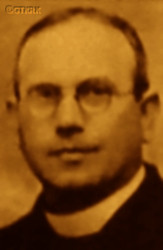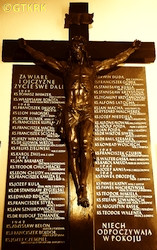Roman Catholic
St Sigismund parish
05-507 Słomczyn
85 Wiślana Str.
Konstancin deanery
Warsaw archdiocese, Poland
full list:
displayClick to display full list

searchClick to search full list by categories
wyświetlKliknij by wyświetlić pełną listę po polsku

szukajKliknij by przeszukać listę wg kategorii po polsku

Martyrology of the clergy — Poland
XX century (1914 – 1989)
personal data
surname
DROZDEK
forename(s)
Paul (pl. Paweł)
function
diocesan priest
creed
Latin (Roman Catholic) Church RCmore on
en.wikipedia.org
[access: 2014.09.21]
diocese / province
Katowice diocesemore on
en.wikipedia.org
[access: 2013.05.19]
Wrocław diocesemore on
en.wikipedia.org
[access: 2013.05.19]
date and place
of death
05.01.1945

Magdeburgtoday: Magdeburg urban dist., Saxony‐Anhalt state, Germany
more on
en.wikipedia.org
[access: 2022.11.20]
details of death
In the years before the outbreak of World War I, considered by the Germans as an „agitator of Polishness” and a „threat to the German Reich” — became known as a Polish activist during his studies in Wrocław, where was active in the seminary's „Polish Circle”, which aimed to raise the level of knowledge of the Polish language among theologians, and which was viewed with suspicion even by the German Ordinary of Wrocław, George Cardinal Kopp — and was often transferred from parish to parish.
In 04.1921 — during preparations to the plebiscite, organized as a result of the Treaty of Versailles of 28.06.1919 ending the World War I, that on 20.03.1921 was to decide state fate of Upper Silesia and Opole region — beaten up in his Jędrysek parish by German thugs and jailed by Germans in Wołczyn prison. Released — returned to his parish, in the meantime as a result of the plebiscite awarded to Polish Republic.
After German invasion of Poland on 01.09.1939 (Russians attacked Poland on 17.09.1939) and start of the World War II, after start of German occupation, arrested by the Germans in 09.1939. The reason may have been a sermon delivered on the day of the German invasion of Poland, during which i.a. said: „Do not cry and do not be afraid, because Hitler will not win this war! God will not allow it!”. Released after a few weeks.
Arrested again at the end of 1942.
On 04.12.1942 sentenced in Opole prob. by German summary Germ. Sondergericht (pl. sąd specjalny) to 3 years imprisonment for a defamation of the German Nazi party, predicting German defeat in war and for listening to foreign radio stations.
Jailed in Bautzen penal prison.
There again on 29.11.1943 tried by the German summary court niem.
Sondergericht in Dresden and sentenced to 3 years imprisonment for prisoners' incitement. During the trial, was to say: „If there is a God, then Germany must lose the war, and as a believing Christian and priest, I must condemn Hitler's national–socialism by force of fact”.
Perished in Magdeburg penal prison.
cause of death
exhaustion
perpetrators
Germans
sites and events
MagdeburgClick to display the description, BautzenClick to display the description, «Intelligenzaktion»Click to display the description, Ribbentrop‐MolotovClick to display the description, Pius XI's encyclicalsClick to display the description, Silesian UprisingsClick to display the description
date and place
of birth
11.01.1878

Ujazdtoday: Ujazd gm., Strzelce Opolskie pov., Opole voiv., Poland
more on
en.wikipedia.org
[access: 2021.04.02]
parents
DROZDEK Anthony
🞲 ?, ? — 🕆 ?, ?

HENKEL Mary
🞲 ?, ? — 🕆 ?, ?
presbyter (holy orders)
ordination
20.06.1903

positions held
01.10.1919 – 1942
parish priest — Jędrysektoday: part of Kalety, Kalety urban gm., Tarnowskie Góry pov., Silesia voiv., Poland
more on
en.wikipedia.org
[access: 2022.01.12] ⋄ St Joseph RC parish ⋄ Tarnowskie Górytoday: Tarnowskie Góry pov., Silesia voiv., Poland
more on
en.wikipedia.org
[access: 2022.01.28] RC deanery
28.11.1912 – 1919
vicar — Mikulczycetoday: district of Zabrze, Zabrze city pov., Silesia voiv., Poland
more on
en.wikipedia.org
[access: 2021.04.02] ⋄ St Lawrence the Deacon and Martyr RC parish ⋄ Zabrzetoday: Zabrze city pov., Silesia voiv., Poland
more on
en.wikipedia.org
[access: 2021.04.02] RC deanery
1912
vicar — Opoletoday: Opole city pov., Opole voiv., Poland
more on
en.wikipedia.org
[access: 2021.04.02] ⋄ Exaltation of the Holy Cross RC parish ⋄ Opoletoday: Opole city pov., Opole voiv., Poland
more on
en.wikipedia.org
[access: 2021.04.02] RC deanery
from 01.02.1912
vicar — Dobrodzieńtoday: Dobrodzień gm., Olesno pov., Opole voiv., Poland
more on
en.wikipedia.org
[access: 2022.02.15] ⋄ St Mary Magdalene RC parish ⋄ Lubliniectoday: Lubliniec urban gm., Lubliniec pov., Silesia voiv., Poland
more on
en.wikipedia.org
[access: 2021.04.02] RC deanery
1911 – 1912
vicar — Stare Siołkowicetoday: Popielów gm., Opole pov., Opole voiv., Poland
more on
en.wikipedia.org
[access: 2022.01.12] ⋄ St Michael the Archangel RC parish ⋄ Stare Siołkowicetoday: Popielów gm., Opole pov., Opole voiv., Poland
more on
en.wikipedia.org
[access: 2022.01.12] RC deanery
1911
vicar — Rybniktoday: Grabów gm., Łęczyca pov., Łódź voiv., Poland
more on
pl.wikipedia.org
[access: 2022.01.28] ⋄ St Anthony of Padua RC parish ⋄ Żorytoday: Żory city pov., Silesia voiv., Poland
more on
en.wikipedia.org
[access: 2020.11.27] RC deanery
27.06.1908 – 1911
vicar — Świętochłowicetoday: Świętochłowice city pov., Silesia voiv., Poland
more on
en.wikipedia.org
[access: 2021.04.02] ⋄ St Peter and St Paul the Apostles RC parish ⋄ Mysłowicetoday: Mysłowice city pov., Silesia voiv., Poland
more on
en.wikipedia.org
[access: 2021.04.02] RC deanery
23.11.1906 – 1908
vicar — Szczecintoday: Szczecin city pov., West Pomerania voiv., Poland
more on
en.wikipedia.org
[access: 2021.12.18] ⋄ St John the Baptist RC parish ⋄ Szczecintoday: Szczecin city pov., West Pomerania voiv., Poland
more on
en.wikipedia.org
[access: 2021.12.18] RC deanery
23.09.1905 – 1906
vicar — Weißenseetoday: locality Berlin‐Weißensee in Berlin, Pankow borough, Berlin state, Germany
more on
en.wikipedia.org
[access: 2022.07.21] ⋄ St Joseph RC parish ⋄ Charlottenburgtoday: locality in Berlin, Charlottenburg‐Wilmersdorf borough, Berlin state, Germany
more on
en.wikipedia.org
[access: 2022.01.07] RC deanery
30.09.1903 – 1905
vicar — Żorytoday: Żory city pov., Silesia voiv., Poland
more on
en.wikipedia.org
[access: 2020.11.27] ⋄ St Philip and St James the Apostles RC parish ⋄ Żorytoday: Żory city pov., Silesia voiv., Poland
more on
en.wikipedia.org
[access: 2020.11.27] RC deanery
1903
vicar — Ujazdtoday: Ujazd gm., Strzelce Opolskie pov., Opole voiv., Poland
more on
en.wikipedia.org
[access: 2021.04.02] ⋄ St Andrew the Apostle RC parish ⋄ Ujazdtoday: Ujazd gm., Strzelce Opolskie pov., Opole voiv., Poland
more on
en.wikipedia.org
[access: 2021.04.02] RC deanery
1899 – 1903
student — Wrocławtoday: Wrocław city pov., Lower Silesia voiv., Poland
more on
en.wikipedia.org
[access: 2021.04.02] ⋄ philosophy and theology, Department of Catholic Theology, University of Wrocław [i.e. University of Wrocław (since 1945) / Frederic Wilhelm University of Silesia (1911‐1945) / Royal University i.e. Breslau Academy (1816‐1911)]
sites and events
descriptions
Magdeburg: German penal prison.
Bautzen: There were two prisons in Bautzen: Bautzen I, the state prison of Saxony founded in 1904 — known as Germ. „Gelbes Elend” (Eng. „Yellow misery”) — and Bautzen II, founded in 1906. During the rule of the democratically elected German National Socialist Party NSDAP (1933‐1945), both prisons housed political prisoners. During World War II, the Ortenburg Castle in Bautzen was also transformed into a prison. Many prisoners — held in inhumane conditions — were Poles. After the end of the hostilities of World War II, the prisons first became part of the Russian Special Camp (1945‐1956) and then the prisons of the political police Stasi of communist Germany.
«Intelligenzaktion»: German: «Intelligenzaktion» (English: „Intelligence Action”) — a German program of extermination of the Polish elite, mainly the intelligentsia and leadership layers, carried out from the beginning of the occupation in w 09.1939 to 04.1940, mainly in territories directly annexed to Germany, but also in the so‐called Germ. Generalgouvernement (Eng. General Governorate), where it was called «AB‐aktion». In the first phase, immediately after the beginning of the German occupation, during military operations carried out by the Germ. Wehrmacht (Eng. Armed Forces) and the genocidal units of the Germ. Einsatzgruppen (Eng. Operational Groups) of the Germ. Sicherheitspolizei (Eng. Security Police), i.e. SiPo, and Germ. Sicherheitsdienst des Reichsführers SS (Eng. Security Service of the Reichsführer SS), i.e. SD, organized by the Germ. Reichssicherheitshauptamt (Eng. Reich Main Security Office), i.e. RSHA, which followed the troops, carried out under the Germ. Unternehmen „Tannenberg” (Eng. Operation „Tannenberg”) — based on the so‐called Germ. Sonderfahndungsliste (Eng. Special Wanted Lists), i.e. proscription lists of Poles considered particularly dangerous to the Third Reich, prepared by the Zentralstelle II/P (Polen) unit of the German RSHA. Later, implemented by the German civilian occupation authorities and the genocidal unit of the Germ. Volksdeutscher Selbstschutz (Eng. Ethnic Germans Self‐Defense), whose members were Germ. Volksdeutsche (Eng. Ethnic Germans), i.e. representatives of the German minority in Poland. According to various sources, these lists, at the beginning of 09.1939, could have contained the details of 61,000—88,000 „dangerous” Poles — although these figures cannot be confirmed. In total, during this genocide, c. 50,000 teachers, Catholic priests, representatives of the landed gentry, freelancers, social and political activists, and retired military personnel were systematically and methodically murdered. Another 50,000 were sent to concentration camps, where only a negligible percentage survived. (more on: en.wikipedia.orgClick to attempt to display webpage
[access: 2014.10.04])
Ribbentrop‐Molotov: Genocidal Russian‐German alliance pact between Russian leader Joseph Stalin and German leader Adolf Hitler signed on 23.08.1939 in Moscow by respective foreign ministers, Mr. Vyacheslav Molotov for Russia and Joachim von Ribbentrop for Germany. The pact sanctioned and was the direct cause of joint Russian and German invasion of Poland and the outbreak of the World War II in 09.1939. In a political sense, the pact was an attempt to restore the status quo ante before 1914, with one exception, namely the „commercial” exchange of the so‐called „Kingdom of Poland”, which in 1914 was part of the Russian Empire, fore Eastern Galicia (today's western Ukraine), in 1914 belonging to the Austro‐Hungarian Empire. Galicia, including Lviv, was to be taken over by the Russians, the „Kingdom of Poland” — under the name of the General Governorate — Germany. The resultant „war was one of the greatest calamities and dramas of humanity in history, for two atheistic and anti‐Christian ideologies — national and international socialism — rejected God and His fifth Decalogue commandment: Thou shall not kill!” (Abp Stanislav Gądecki, 01.09.2019). The decisions taken — backed up by the betrayal of the formal allies of Poland, France and Germany, which on 12.09.1939, at a joint conference in Abbeville, decided not to provide aid to attacked Poland and not to take military action against Germany (a clear breach of treaty obligations with Poland) — were on 28.09.1939 slightly altered and made more precise when a treaty on „German‐Russian boundaries and friendship” was agreed by the same murderous signatories. One of its findings was establishment of spheres of influence in Central and Eastern Europe and in consequence IV partition of Poland. In one of its secret annexes agreed, that: „the Signatories will not tolerate on its respective territories any Polish propaganda that affects the territory of the other Side. On their respective territories they will suppress all such propaganda and inform each other of the measures taken to accomplish it”. The agreements resulted in a series of meeting between two genocidal organization representing both sides — German Gestapo and Russian NKVD when coordination of efforts to exterminate Polish intelligentsia and Polish leading classes (in Germany called «Intelligenzaktion», in Russia took the form of Katyń massacres) where discussed. Resulted in deaths of hundreds of thousands of Polish intelligentsia, including thousands of priests presented here, and tens of millions of ordinary people,. The results of this Russian‐German pact lasted till 1989 and are still in evidence even today. (more on: en.wikipedia.orgClick to attempt to display webpage
[access: 2015.09.30])
Pius XI's encyclicals: Facing the creation of two totalitarian systems in Europe, which seemed to compete with each other, though there were more similarities than contradictions between them, Pope Pius XI issued in 03.1937 (within 5 days) two encyclicals. In the „Mit brennender Sorge” (Eng. „With Burning Concern”) published on 14.03.1938, condemned the national socialism prevailing in Germany. The Pope wrote: „Whoever, following the old Germanic‐pre‐Christian beliefs, puts various impersonal fate in the place of a personal God, denies the wisdom of God and Providence […], whoever exalts earthly values: race or nation, or state, or state system, representatives of state power or other fundamental values of human society, […] and makes them the highest standard of all values, including religious ones, and idolizes them, this one […] is far from true faith in God and from a worldview corresponding to such faith”. On 19.03.1937, published „Divini Redemptoris” (Eng. „Divine Redeemer”), in which criticized Russian communism, dialectical materialism and the class struggle theory. The Pope wrote: „Communism deprives man of freedom, and therefore the spiritual basis of all life norms. It deprives the human person of all his dignity and any moral support with which he could resist the onslaught of blind passions […] This is the new gospel that Bolshevik and godless communism preaches as a message of salvation and redemption of humanity”… Pius XI demanded that the established human law be subjected to the natural law of God , recommended the implementation of the ideal of a Christian state and society, and called on Catholics to resist. Two years later, National Socialist Germany and Communist Russia came together and started World War II. (more on: www.vatican.vaClick to attempt to display webpage
[access: 2023.05.28], www.vatican.vaClick to attempt to display webpage
[access: 2023.05.28])
Silesian Uprisings: Three armed interventions of the Polish population against Germany in 1919‐1921 aiming at incorporation of Upper Silesia and Opole region into Poland, after the revival of the Polish state in 1918. Took place in the context of a plebiscite ordered on the basis of the international treaty of Versailles of 28.06.1919, ending the First World War, that was to decide national fate of the disputed lands. The 1st Uprising took place on 16‐24.08.1919 and broke out spontaneously in response to German terror and repression against the Polish population. Covered mainly Pszczyna and Rybnik counties and part of the main Upper Silesia industrial district. Suppressed by the Germans. 2nd Uprising took place on 19‐25.08.1920 in response to numerous acts of terror of the German side. Covered the entire area of the Upper Silesia industrial district and part of the Rybnik county. As a result Poles obtained better conditions for the campaign prior the plebiscite. The poll was conducted on 20.03.1921. The majority of the population — 59.6% — were in favor of Germany, but the results were influenced by the admission of voting from former inhabitants of Upper Silesia living outside Silesia. As a result the 3rd Uprising broke out, the largest such uprising of the Silesian in the 20th century. It lasted from 02.05.1921 to 05.07.1921. Spread over almost the entire area of Upper Silesia. Two large battles took place in the area of St. Anna Mountain and near Olza. As a result on 12.10.1921 the international plebiscite commission decided on a more favorable for Poland division of Upper Silesia. The territory granted to Poland was enlarged to about ⅓ of the disputed territory. Poland accounted for 50% of metallurgy and 76% of coal mines. (more on: en.wikipedia.orgClick to attempt to display webpage
[access: 2020.05.25])
sources
personal:
encyklo.plClick to attempt to display webpage
[access: 2021.12.19]
original images:
www.alamy.comClick to attempt to display webpage
[access: 2023.08.22], thema.erzbistum-koeln.deClick to attempt to display webpage
[access: 2018.02.15]
LETTER to CUSTODIAN/ADMINISTRATOR
If you have an Email client on your communicator/computer — such as Mozilla Thunderbird, Windows Mail or Microsoft Outlook, described at WikipediaPatrz:
en.wikipedia.org, among others — try the link below, please:
LETTER to CUSTODIAN/ADMINISTRATORClick and try to call your own Email client
If however you do not run such a client or the above link is not active please send an email to the Custodian/Administrator using your account — in your customary email/correspondence engine — at the following address:

giving the following as the subject:
MARTYROLOGY: DROZDEK Paul
To return to the biography press below:
 Click to return to biography
Click to return to biography











